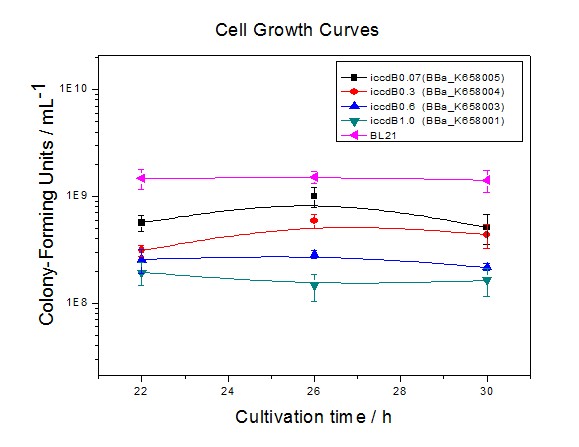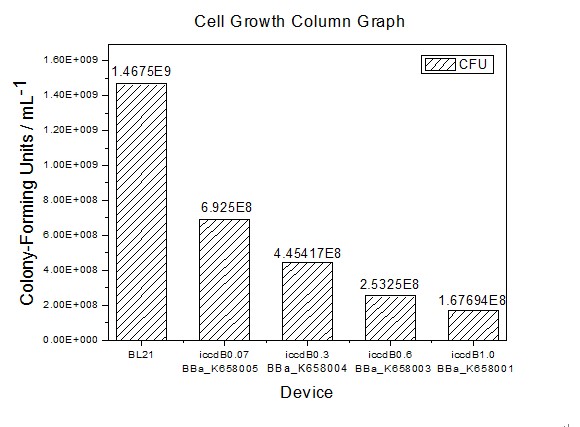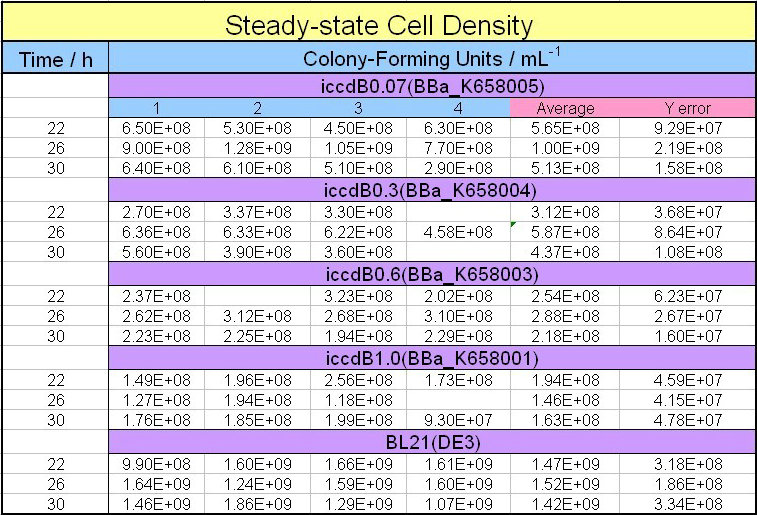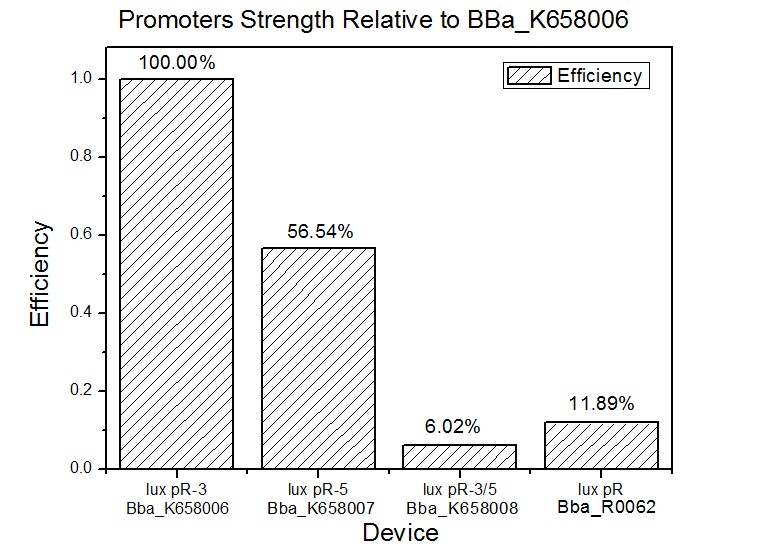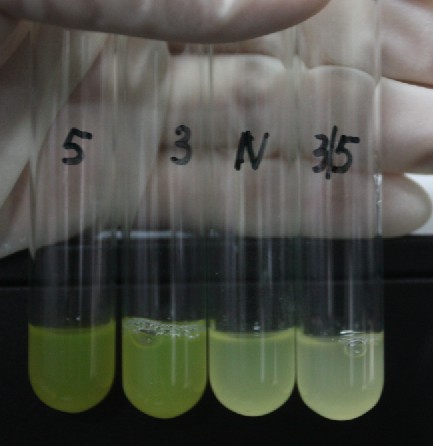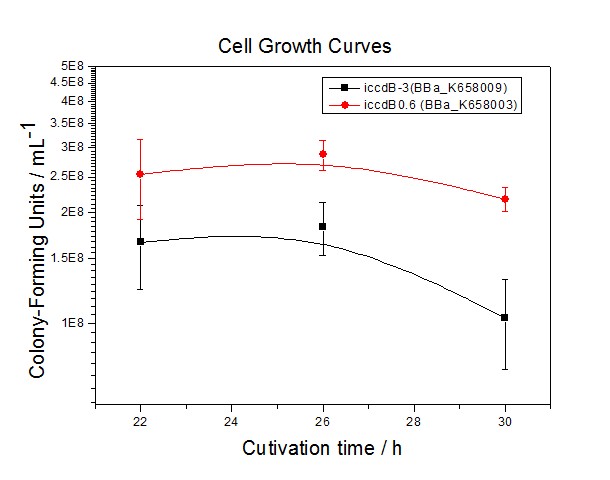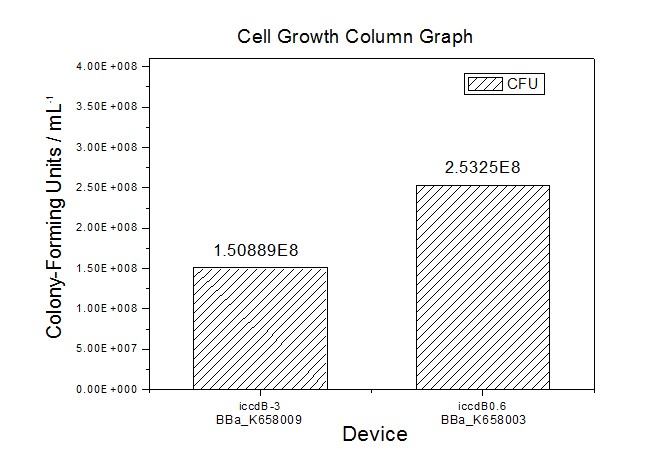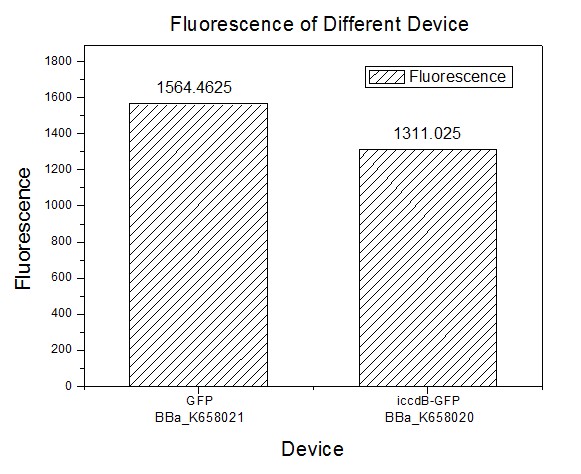Team:XMU-China/Result
From 2011.igem.org
(Difference between revisions)
(→iccdB->GFP) |
|||
| (7 intermediate revisions not shown) | |||
| Line 37: | Line 37: | ||
The results are shown in following figures: | The results are shown in following figures: | ||
| - | |||
| - | [[Image: | + | [[Image:XMU_China_122.jpg|left|Figure 4 Efficiency of promoter lux pR (BBa_R0062) and its three mutants |
| - | |frame|Figure | + | |frame|Figure 4 Efficiency of promoter lux pR (BBa_R0062) and its three mutants.]] |
| - | [[Image:XMU_China_119.jpg|left|Figure | + | [[Image:XMU_China_119.jpg|left|Figure 5: Fluorescence of four IR-GFP devices at 20h. 5, 3, 3/5, N represent for IR-3-GFP (BBa_K658017), IR-5-GFP (BBa_K658018), IR-3/5-GFP (BBa_K658019) and IR-GFP (BBa_K658016) respectively|frame|Figure 5: Fluorescence of four IR-GFP devices at 20h. 5, 3, 3/5, N represent for IR-3-GFP (BBa_K658017), IR-5-GFP (BBa_K658018), IR-3/5-GFP (BBa_K658019) and IR-GFP (BBa_K658016) respectively.]] |
<html> | <html> | ||
| Line 48: | Line 47: | ||
</html> | </html> | ||
| - | Figure 4 | + | Figure 4 and figure 5 illustrate that mutated promoters lux pR-3 (BBa_K658006) and lux R-5 (BBa_K658007) dramatically increased the fluorescence intensity at steady state compared with wild type promoter lux pR (R0062), while mutated promoter lux pR-3/5 (BBa_K658008) gave an even weaker expression of GFP than promoter lux pR (R0062). It might be explained that the mutagenesis at position 3 and position 5 of the sequence of lux pR (R0062) changed the binding strength between promoter lux pR and protein luxR. |
| - | + | ||
| - | + | ||
| + | As is shown in figure 4, promoter lux pR-3 has the highest strength of the four. Mutation at position 3 might lower the threshold for the binding reaction between LuxR/AHL protein complex and promoter lux pR, which starts the Quorum Sensing system at a relatively earlier period with a lower cell density compared with circuits regulated by wild type promoter lux pR (BBa_R0062). The earlier the QS system is started, the more GFP might be produced, leading to a higher fluorescence intensity at steady state. | ||
==Population-control devices with mutated promoters== | ==Population-control devices with mutated promoters== | ||
| - | [[Image:XMU_China_120.jpg|left|Figure | + | [[Image:XMU_China_120.jpg|left|Figure 6 Experimentally measured steady-state cell density of iccdB0.6(BBa_K658003) and iccdB-3 (BBa_K658009)|frame|Figure 6 Experimentally measured steady-state cell density of iccdB0.6(BBa_K658003) and iccdB-3 (BBa_K658009).]] |
| - | [[Image:XMU_China_121.jpg|left|Figure | + | [[Image:XMU_China_121.jpg|left|Figure 7 Average of experimentally measured cell densities of BL21’s cells with iccdB0.6 (BBa_K658003) and its mutant iccdB-3 (BBa_K658009)|frame|Figure 7 Average of experimentally measured cell densities of BL21’s cells with iccdB0.6 (BBa_K658003) and its mutant iccdB-3 (BBa_K658009).]] |
<html> | <html> | ||
<img src="http://partsregistry.org/wiki/images/4/41/XMU_China_block.jpg"> | <img src="http://partsregistry.org/wiki/images/4/41/XMU_China_block.jpg"> | ||
| Line 66: | Line 64: | ||
| - | Figure | + | Figure 6 and Figure 7 illustrate that the population-control device iccdB-3 programs a relatively lower steady-state cell density compared with iccdB0.6. This matched the result of the test on four lux pR promoters’ strength in our IR-GFP device (BBa_K658016). The strength of lux pR promoters were defined as follows: |
| - | [[Image:XMU_China_122.jpg|left|Figure | + | [[Image:XMU_China_122.jpg|left|Figure 8 Efficiency of promoter lux pR (R0062) and its 3 mutants|frame|Figure 8 Efficiency of promoter lux pR (R0062) and its 3 mutants.]] |
<html> | <html> | ||
<img src="http://partsregistry.org/wiki/images/4/41/XMU_China_block.jpg"> | <img src="http://partsregistry.org/wiki/images/4/41/XMU_China_block.jpg"> | ||
| Line 75: | Line 73: | ||
| - | As is shown in figure | + | As is shown in figure 8, promoter lux pR-3 has the highest strength of the four. It is probable that mutation at position 3 lowers the threshold for the binding reaction between LuxR/AHL protein complex and promoter lux pR, which starts the Quorum Sensing system at a relatively earlier period with a lower cell density compared with circuits regulated by wild type promoter lux pR (BBa_R0062). |
Once the QS system is started, downstream killer protein expresses. The viable cell density reaches a steady state when cell growth rate equals to its death rate. Generally, steady-state cell density seems to fluctuate at the cell density when QS is started. Thus, the higher strength a promoter has, the earlier the population-control device is started, leading to a lower steady-state cell density. | Once the QS system is started, downstream killer protein expresses. The viable cell density reaches a steady state when cell growth rate equals to its death rate. Generally, steady-state cell density seems to fluctuate at the cell density when QS is started. Thus, the higher strength a promoter has, the earlier the population-control device is started, leading to a lower steady-state cell density. | ||
The earlier the QS system is started, the more GFP might be produced, leading to a higher fluorescence intensity at steady state. | The earlier the QS system is started, the more GFP might be produced, leading to a higher fluorescence intensity at steady state. | ||
| - | |||
==iccdB->GFP== | ==iccdB->GFP== | ||
| - | [[Image:XMU_China_123.jpg|left|Figure | + | [[Image:XMU_China_123.jpg|left|Figure 9 Experimentally measured fluorescence at steady state of BL21's cells with iccdB0.6-GFP(BBa_K658020) and BBa_K658021|frame|Figure 9 Experimentally measured fluorescence at steady state of BL21's cells with iccdB0.6-GFP(BBa_K658020) and BBa_K658021.]] |
<html> | <html> | ||
<img src="http://partsregistry.org/wiki/images/4/41/XMU_China_block.jpg"> | <img src="http://partsregistry.org/wiki/images/4/41/XMU_China_block.jpg"> | ||
</html> | </html> | ||
Latest revision as of 11:03, 28 October 2011
 "
"



